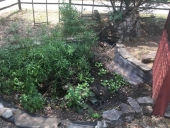


The Humble Soapnut - A Guide to the Laundry Detergent that Grows on Trees ebook by Kathryn Ossing
will be released to subscribers in:
soon!















Cris Bessette wrote:
I'm kinda curious though, you are planning on block walls, but a clay bottom? It seems to me if you are going partially artificial anyways, then why not a liner bottom?
 2
2




Subtropical desert (Köppen: BWh)
Elevation: 1090 ft Annual rainfall: 7"




Thanks for the reply, and good question. My clay content is high enough that I probably don't need a liner at all - I'll do some testing to determine if I need to supplement with bentonite. So I don't need to buy a liner or worry about what to do when it fails eventually. So the block retaining walls are really independent of the liner question. All things being equal, I'd rather not use blocks, but it solves a problem. And I shouldn't need mortar/cement - I can drive some anchor posts into the underlying soil, stack the blocks over those, pack them with dirt/clay - so not totally artificial.
 2
2




Jennifer Wadsworth wrote:Myron - you can check out what your possible evaporation rate might be here: http://www.wrcc.dri.edu/htmlfiles/westevap.final.html#CALIFORNIA Pick the station closest to where you live.




Myron Weber wrote:Sorry if this sounds weird, but I have to say, you are my favorite permie - thanks for all the amazing stuff you post on these forums.


Subtropical desert (Köppen: BWh)
Elevation: 1090 ft Annual rainfall: 7"




Jay C. White Cloud wrote:you have a really good plan started...just a ways to go first.




Jennifer Wadsworth wrote: I can dream though...
















Tom Connolly wrote:Does the data source recommended here take into account only the air temperature? or does it include a wind factor as well?
 1
1




Luke Townsley wrote:I would do some actual math on it though, and carefully take into account your specific circumstances.
On a pond that small, I would also take into account seepage through the clay liner.




Myron Weber wrote:
Luke Townsley wrote:I would do some actual math on it though, and carefully take into account your specific circumstances.
On a pond that small, I would also take into account seepage through the clay liner.
Thanks for the insights. I'm still concerned about the evaporation, but not so much that I'm throwing in the towel by any means. My next step will be to get some empirical data by burying some 5-gal buckets up the rim in both sun and shade, and seeing how fast the water evaporates. That will give a baseline for the shallow parts independent of seepage.
BTW - I was a lifelong Indiana boy until I met a California girl and ended up here. I spent a lot of time in my early 20s driving around the Terre Haute, Vincennes, Bloomington areas, and actually know where Dugger IN is.
 1
1




"You must be the change you want to see in the world." "First they ignore you, then they laugh at you, then they fight you, then you win." --Mahatma Gandhi
"Preach the Gospel always, and if necessary, use words." --Francis of Assisi.
"Family farms work when the whole family works the farm." -- Adam Klaus
 1
1




R Scott wrote:A shade sail will greatly reduce evaporation for very little money





Subtropical desert (Köppen: BWh)
Elevation: 1090 ft Annual rainfall: 7"
 1
1




Jennifer Wadsworth wrote:Depending on how big your pond is, you could also put a trellis with vines over it. I know Geoff Lawton puts trellises over his swales in Jordan. From: http://permaculturenews.org/2014/02/01/desert-oasis-4-years-jordan/




Luke Townsley wrote:
When we lived in the Dominican Repermies, we had a vine known locally as "Chinola" that bore orange-like fruits by the same name. I don't know what it is called in English, but it was an extremely growthy vine that was fairly hardy there and would be awesome for something like that if your climate supports it. The fruit was used widely for juice.
Edited to add: I believe this is it: http://en.wikipedia.org/wiki/Passiflora_edulis

Subtropical desert (Köppen: BWh)
Elevation: 1090 ft Annual rainfall: 7"
 1
1
















 Busy with PDC. That said, this link might prove useful: http://www.nwedible.com/2014/08/can-you-seal-a-pond-with-clay-kitty-litter-2-html.html
Busy with PDC. That said, this link might prove useful: http://www.nwedible.com/2014/08/can-you-seal-a-pond-with-clay-kitty-litter-2-html.html

| I agree. Here's the link: http://stoves2.com |




